Orthopedic Surgery
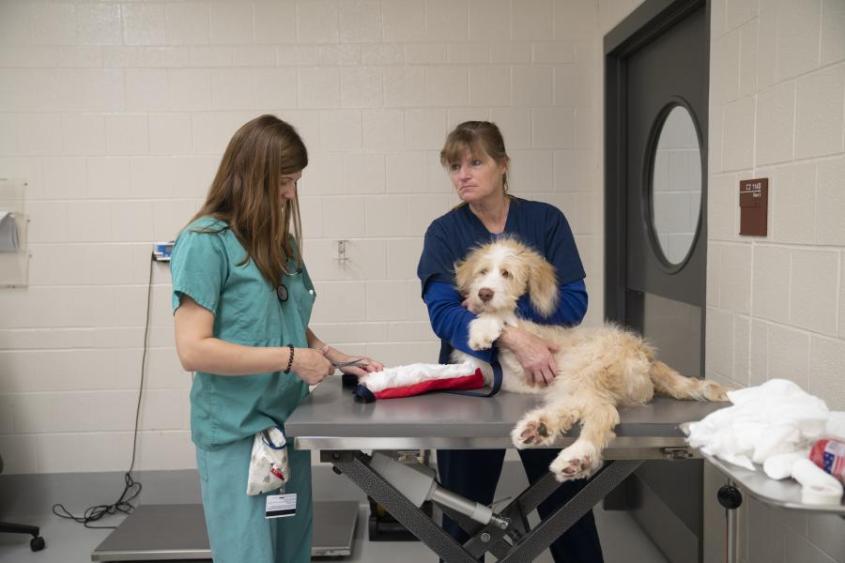
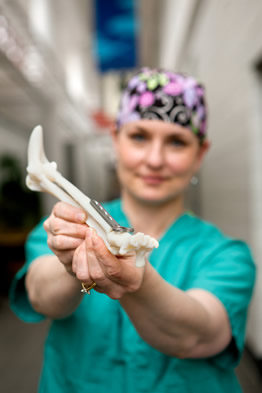 The Orthopedic Surgery Service at the Cornell University Hospital for Animals treats dogs and cats with injuries and diseases of the musculoskeletal system. We provide a full range of services - from screening and diagnosis to treatment and rehabilitation - for conditions including hereditary joint disorders, cruciate ligament tears, patella luxation, fractures and arthritis.
The Orthopedic Surgery Service at the Cornell University Hospital for Animals treats dogs and cats with injuries and diseases of the musculoskeletal system. We provide a full range of services - from screening and diagnosis to treatment and rehabilitation - for conditions including hereditary joint disorders, cruciate ligament tears, patella luxation, fractures and arthritis.
Our board-certified surgeons have more than 25 years of combined experience. They are joined by anesthesiology specialists, who supervise all procedures before and during operations. Our services are integrated with other specialties across the hospital, such as imaging and nutrition, and we frequently seek out consultations and referrals to ensure your pet received comprehensive care. Also, we consult with and refer patients to the Pediatrics and Medical Genetics Service.
Advanced Techniques
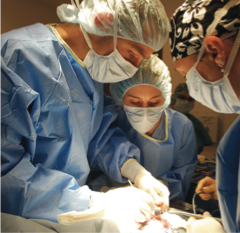 Total hip replacement
Total hip replacement- Total knee replacement
- Total elbow replacement
- Arthroscopic joint surgery
- Advanced cruciate ligament repair - tibial plateau leveling osteotomy, tibial tuberosity advancement
- Minimally-invasive fracture surgery
- Stem cell and platelet rich plasma administration
- Gait analysis
- Ligament and tendon reconstruction
- Limb deformity correction
- 3D printing
- Hip, elbow, patella evaluation for OFA provisional and final certification. DLS method for hip laxity and conformation is preferred for breeding and puppy selection
- Estimated breeding values for hip and elbow dysplasia are available for dogs registered in the OFA system.
- Hip score breeding value search application available ONLINE!
Orthopedic Surgery: Medical Conditions
Rupture of the anterior cruciate ligament or cranial cruciate ligament
Dogs of any age or breed can tear knee ligaments, most commonly the anterior cruciate ligament (ACL) and cranial cruciate ligament (CCL). Rupturing either ligament causes varying degrees of lameness. If ruptures affect both knees or are associated with a tear of a meniscus in the knee, the injury is very debilitating.
A ruptured knee ligament is diagnosed by palpation and x-ray, but MRI can be used in subtle cases with partial tears of the ACL. Surgery is the primary treatment. There are many surgical options, but there are basically two broad categories. Extracapsular suture methods stabilize the knee outside the joint and restore the function of the cruciate ligament rather than replacing the damaged ligament. Tibial osteotomy techniques change the anatomy of the knee joint by eliminating or neutralizing the slope in the tibial plateau. Prognosis for function of the affected leg after either procedure is good to excellent for most dogs. Some dogs never fully recover due to advanced arthritis, which cannot be reversed.
Hip dysplasia
Hip dysplasia is a common genetic trait of many dog breeds, but most common in large and giant breeds. It is characterized by malformation of the hip where the ball and socket of the joint do not fit properly together. The mechanical instability leads to arthritis, which can be exacerbated by obesity. The condition may be managed medically in many dogs, but some need surgical treatment.
Reduction in body weight is always recommended for successful arthritis treatment. Surgical treatments include:
- Juvenile pubic symphysiodesis, or JPS, a procedure for younger dogs that manipulates the way the pelvis grows to create a tighter hip.
- Triple pelvic osteotomy, or TPO, a surgery that increases the depth of the shallow hip socket , which allows it better connect to head of the femur, increasing the stability of the hip joint.
- Femoral head and neck excision involves removing the head of the femur. Soft tissues support the false hip joint. A fibrous pad buffers the space between to cup the femur. This surgery is used most frequently in severe cases.
- Total hip replacement has the highest rate of success, especially in severe cases, since it completely replaces the faulty joint.
The best surgical treatment depends on the age of the dog and the animal's response to medical management. The long-term prognosis for hip dysplasia depends on the procedure undertaken and how well the rehab is done.
Elbow dysplasia
Elbow dysplasia is a common genetic trait of many dog breeds, but most common in large and giant breeds. There are several disorders in the elbow that comprise elbow dysplasia, but all involve the growth of cartilage or the structures surrounding it. The diagnosis of elbow dysplasia is made through examination, x-rays or CT scan, and sometimes a combination of the three.
Some cases are treatable with arthroscopic surgery, while others require complicated osteotomies, where a surgeon may shorten or lengthen a bone. In older dogs, elbow dysplasia may be managed medically or surgically, depending on a variety of factors.
The prognosis for functional recovery after surgery depends on the age of the patient and severity of their condition.
Fractures
Fractures, or broken bones, frequently occur when dogs and cats are hit by motor vehicles, although other accidents also result in fractures.
Before treating any fractures, we conduct a thorough examination to rule out other injuries to the head, chest, abdomen and urinary tract. Then, a diagnosis is made by x-ray. In cases where multiple traumatic injuries are suspected, CT scan is recommended.
Open fractures, where the skin is broken over the fracture or bone is exposed, are most commonly treated using external fixation, where a fixator or metal rod is used outside of the body to stabilize the bone. Closed fractures are typically treated with plates and screws placed internally to stabilize the broken bones.
The prognosis is good for most fractures. If the joint near the fracture is involved, the prognosis is often guarded due to cartilage injury within the joint. In these cases, arthritis will likely develop over the medium to long term.
What to Expect During Your Appointment
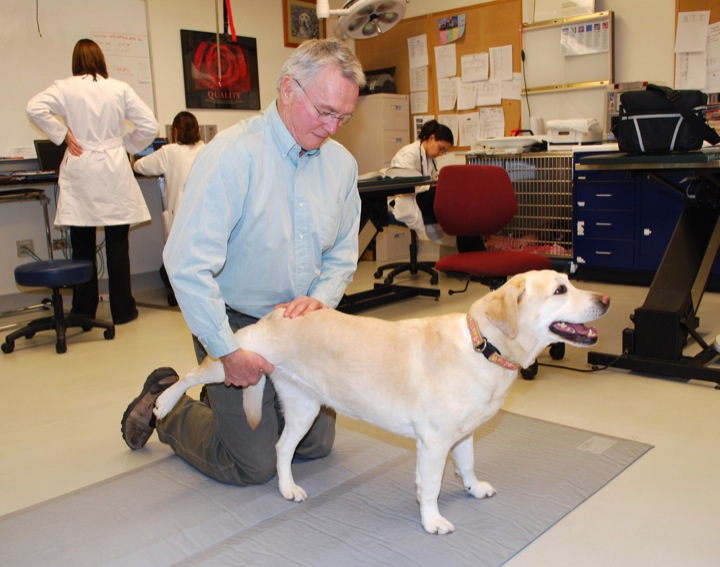 Your scheduled visit to the Orthopedic Surgery Service at the Cornell University Hospital for Animals begins with check in at the reception desk. Following a small amount of paperwork, you will be greeted in the waiting room by one or two students currently in their surgery rotation and brought to a private examination room.
Your scheduled visit to the Orthopedic Surgery Service at the Cornell University Hospital for Animals begins with check in at the reception desk. Following a small amount of paperwork, you will be greeted in the waiting room by one or two students currently in their surgery rotation and brought to a private examination room.
The students will conduct an examination of your pet and ask you questions about your animal's history and current health. We appreciate your patience and understanding in allowing these future veterinarians to interact with you and your pet.
The students will then leave to consult with a faculty member about the history, physical examination and recommendations for case management. Your pet will usually be examined away from you. The orthopedic team will accompany the student back to your examination room to examine your pet again and discuss options for imaging studies and other diagnostic tests.
Often, you will be asked to leave your pet in the care of our students so that we can begin appropriate testing. Given our schedule and consultations with other specialists regarding your pet's care, you may be asked to return to discuss our findings later in the day. Although you may not meet the faculty chief of service, all cases are discussed with the service chief and many patients are examined by three or more doctors.
Once our orthopedic team has formed a diagnosis, they will meet with you to discuss a set of medical and surgical options tailored to your needs and those of your companion, including financial estimates. Often animals that require a procedure will be scheduled for surgery the day following their initial appointment. We offer convenient overnight stays for animals with next-day surgeries.
Patients recovering from orthopedic injuries or surgeries typically stay in the hospital for several
days. You animal may also be referred to our colleagues for rehabilitation, pain management or nutrition services.
Success Stories
Smokey
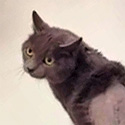 Smokey, a 5 year old female cat, presented to the Emergency Service at the Cornell University Hospital for Animals for hind limb paralysis. Smokey had been playing with her canine brother when she accidentally crashed into a table, and immediately lost the ability to move her back legs. She was taken to her regular veterinarian, who diagnosed a spinal fracture on x-rays, and referred Smokey to Cornell for emergency surgery. Upon arrival Smokey was unable to move her legs, and the doctors were unsure whether she was even able to feel them. Despite a very guarded prognosis, Smokey's owners wanted to give her every chance they could for recovery. A CT scan confirmed a lumbar spinal fracture with compression of the spinal cord, and Smokey was taken to surgery to remove the compressive bony fragments and stabilize the fracture. The following morning, Smokey was miraculously able to feel AND move both of her hind limbs. She was an amazing patient, purring and nuzzling throughout her stay. While it is not uncommon for patients like Smokey to stay in the hospital for at least a week, Smokey was discharged just 3 days later (the day after Christmas), and was already able to stand on her own! She continued to improve in leaps and bounds at home, and was running around the exam at her 2 week recheck.
Smokey, a 5 year old female cat, presented to the Emergency Service at the Cornell University Hospital for Animals for hind limb paralysis. Smokey had been playing with her canine brother when she accidentally crashed into a table, and immediately lost the ability to move her back legs. She was taken to her regular veterinarian, who diagnosed a spinal fracture on x-rays, and referred Smokey to Cornell for emergency surgery. Upon arrival Smokey was unable to move her legs, and the doctors were unsure whether she was even able to feel them. Despite a very guarded prognosis, Smokey's owners wanted to give her every chance they could for recovery. A CT scan confirmed a lumbar spinal fracture with compression of the spinal cord, and Smokey was taken to surgery to remove the compressive bony fragments and stabilize the fracture. The following morning, Smokey was miraculously able to feel AND move both of her hind limbs. She was an amazing patient, purring and nuzzling throughout her stay. While it is not uncommon for patients like Smokey to stay in the hospital for at least a week, Smokey was discharged just 3 days later (the day after Christmas), and was already able to stand on her own! She continued to improve in leaps and bounds at home, and was running around the exam at her 2 week recheck.
Cadence
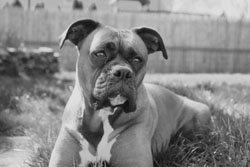 Cadence, an active Boxer, arrived at the Cornell University Hospital for Animals five years ago after being surrendered to a local shelter with a broken leg and several broken ribs. The orthopedic service inserted a metal plate to treat Cadence's fractured leg and helped her find a new home.
Cadence, an active Boxer, arrived at the Cornell University Hospital for Animals five years ago after being surrendered to a local shelter with a broken leg and several broken ribs. The orthopedic service inserted a metal plate to treat Cadence's fractured leg and helped her find a new home.
Cadence returned to Cornell for regular checkups over the next four years. In 2012, her owner noticed Cadence limping on her back right leg. The orthopedic service examined Cadence carefully and found her right stifle was enlarged, painful, and unstable. Radiographs revealed that the knee was swollen consistent with rupture of the cranial (anterior) cruciate ligament (ACL).
The final diagnosis was ruptured cranial cruciate ligament in her right knee, a common cause of debilitating hind limb lameness in dogs of all shapes and sizes.
Dr. Ursula Krotscheck and Dr. Heather M. Knapp-Hoch recommended Tibial Plateau Leveling Osteotomy surgery, which stabilizes the knee joint by changing its anatomy. Dog’s walk in a “crouched” position on their toes with their knees flexed or bent forward. In this position, there is a tendency for the bottom of the thigh bone (femur) to fall off the back of the tibia. The ACL - the ligament that Cadence tore - stops this from happening. When the ACL tears, this falling off occurs and causes arthritis and pain.
The TPLO surgery realigns the surface of the tibia to change the forces during walking, preventing the femur from falling off of the tibia. The TPLO surgery was successful, and Cadence made a full recovery within a month.
A helping hand for Zeus
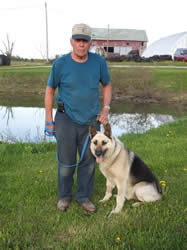 The following letter was shared by a client of the Cornell University Hospital. Please enjoy!
The following letter was shared by a client of the Cornell University Hospital. Please enjoy!
On Saturday March 26, 2011, Zeus ran out to greet my uncle as he drove in the driveway with his van. He was there to fix my dad’s furnace.
It had been icy and when Zeus tried to stop he could not and slid on the ice. He did not go under the vehicle, but slid up against the side of the van with his hip hitting first. That was when Zeus let out a horrible scream of pain and ran to hide on the porch. Everyone scrambled to find him and when we did, it was plain to see he was in horrible pain.
My dad had adopted Zeus at the Auburn SPCA a year earlier; he was now only 3-years-old. He had heart worms and went through all the treatments to get cured. By this time, my dad and Zeus had bonded, and they went everywhere together. My dad called me to come over and see what I thought he should do. I brought my muzzle because it sounded like Zeus was in extreme pain, and I did not want anyone to get bitten if he reacted to being moved. He is such a good-natured boy, but the pain was terrible. We loaded Zeus in the back of the station wagon using a sheet as a sling. My dad seemed numb, almost in shock. He first took Zeus to his vet in Auburn, who took one look at Zeus, gave him a shot for pain, and sent him to Syracuse to an emergency veterinary hospital there.
Dad sat with Zeus for an hour, but was told it would be approximately $3500 just for them to x-ray and take a look at what they could do for him. Dad called asking me where else he could go for help because he did not have that kind of money. He met me in Moravia and Dr. Kerry Norris met us there and took x-rays; we then learned Zeus’s hip had actually popped out of the socket when he banged up against the van. Dr. Norris said his hip socket was a little more shallow on that side and although he had better hips than most German Shepherds, the blunt force had been enough to cause this to happen. She then put him under and worked for several hours trying to get his hip to pop back in the socket. Sadly this did not work. We discussed our options and decided the only hope to save him was to take him to Cornell where a team could assess the damage and hopefully repair his hip. Zeus was given more pain medication, and we drove the 45-minute drive to Cornell.
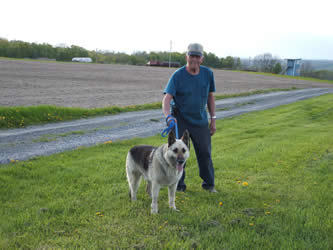 The Cornell doctors assessed the hip injury and determined the best option for Zeus was to remove the ball on his hip. Incredibly, the hip would form scar tissue and form a sort of false hip joint. This would require confining Zeus, keeping him calm, and therapy several times a day with cold and heat packs to help with pain and swelling for several months. When they told my dad how much it would cost, I saw a sad, defeated look come over him and he said he did not know what to do; he could not afford this, but he loved his dog and did not want to let this be the end. He agonized over this for several hours as the doctors did more tests and gave him updates. Then one of the students told him he could apply for help through the patient assistance program: a program where folks donate funds to help cover the cost when a person is struggling to save their pet but cannot afford it. This was the answer to his prayers and this helped saved Zeus' life.
The Cornell doctors assessed the hip injury and determined the best option for Zeus was to remove the ball on his hip. Incredibly, the hip would form scar tissue and form a sort of false hip joint. This would require confining Zeus, keeping him calm, and therapy several times a day with cold and heat packs to help with pain and swelling for several months. When they told my dad how much it would cost, I saw a sad, defeated look come over him and he said he did not know what to do; he could not afford this, but he loved his dog and did not want to let this be the end. He agonized over this for several hours as the doctors did more tests and gave him updates. Then one of the students told him he could apply for help through the patient assistance program: a program where folks donate funds to help cover the cost when a person is struggling to save their pet but cannot afford it. This was the answer to his prayers and this helped saved Zeus' life.
We cannot begin to find the words to thank the people responsible for this warm act of kindness.
We wanted to send you a deeply felt and special thank you and ask you to pass this on to the folks responsible. Again we cannot thank them enough, it is a wonderful, loving thing to do, and we will never forget this.
My dad religiously did the therapy and Zeus is now using his leg again. He again tags along with my dad everywhere he goes, swims in the pond and is my dad’s constant companion. Thank you so much for allowing us to have more time to spend with this wonderful member of our family! Please know we thank you from the bottom of our hearts and will never forget this special gift!
Thanks again,
William N. Denman and his daughter Deb
Related Info
The American College of Veterinary Surgeons
A specialty organization that certifies veterinary surgeons and provides a source of referrals to pet owners.


